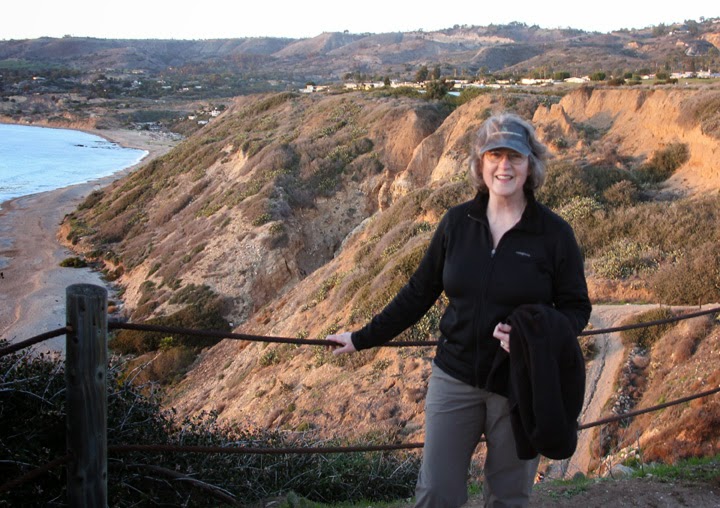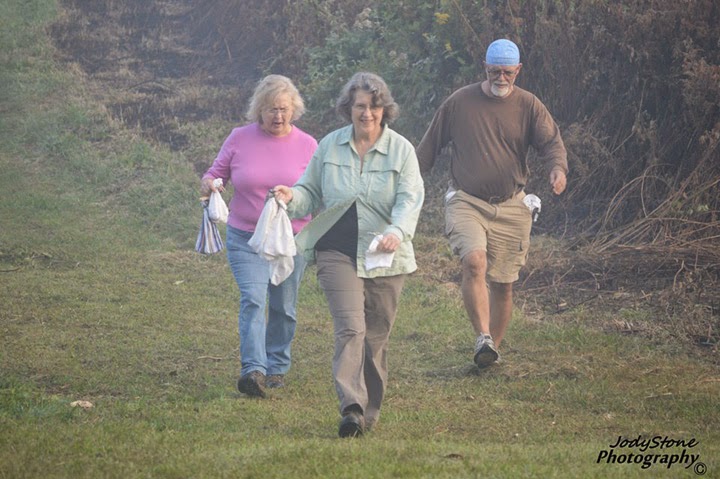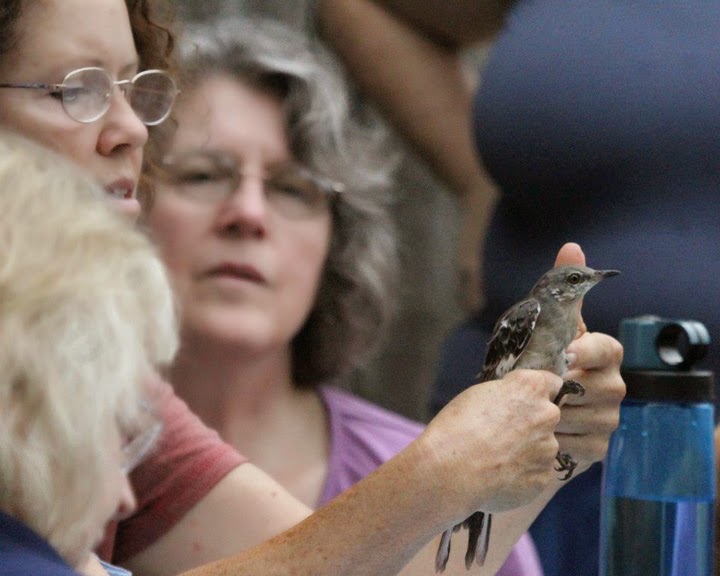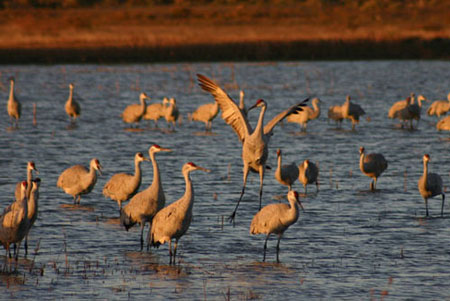I have been thinking lately about all the things I'm grateful for, a feeling that started long before the Thanksgiving holiday arrived. The feeling was helped along by the fact that my laptop screen shattered internally into a million colored lines a couple of weeks ago. This, of course, is not a disaster in the relative world of disasters, not even in the world of computer disasters, but as you may know, it can make you feel temporarily blinded. All digital creative work comes to a screeching halt.
Within a few days, a friend brought me an external screen to use temporarily while I decided what I should do to remedy the problem. This amazed me. Not the friend's instant generosity, but how gently and swiftly a solution arrived. Instead of feeling distress over this unexpected turn of events, all I could feel was gratitude.
And while looking at the image above, that same feeling came over me again. I enjoyed about twenty minutes with this brown creeper at eye-level, and each time I thought she/he had flown away, back she came, no intention of leaving, simply re-positioning herself for better foraging. And if that wasn't gift enough, take a closer look at the image. Notice not only the exquisite camouflaging patterns in the creeper's plumage, but the gorgeous aqua blue lichen, the darker green moss along side it, and those same muted colors glowing from the background light beyond.
All of this captured in the image quite by accident. I was simply being very still, intent on following this little bird with my camera for as long as she would allow it. When I saw this image, I instantly wanted to paint it. It says so much about nature's simple beauty and the hidden wisdom that it holds. A tiny little brown bird, so cleverly blending into the cracks and crevices of a tree's bark with its perfect shape and plumage patterns. Blink your eyes, and she disappears, even when you know she's still right there.
The brown creeper is similar to woodpeckers in that it uses its tail for a brace, spiraling up and around the tree's trunk foraging for insects using it's slender decurved bill like a pair of tweezers. Unlike nuthatches, creepers can only move forward up the tree, not down, facing downward, as nuthatches are able to do. This is part of the reason I kept thinking she was flying away. When she wanted to move down the trunk, she fluttered up from her current position and back down again, landing just where she needed to be.
We are fortunate to have these visitors in the winter months in the Tennessee Valley. They breed in higher elevations in Tennessee and in the northeast, and wander during winter months to warmer climates. Considered solitary in the winter months, according to Sibley's Guide to Bird Life and Behavior, they also may travel in mixed flocks. And small groups of creepers may congregate to roost in tree crevices at night, maximizing their warmth. Can you imagine that? A whole group of cuddling brown creepers!
And if that mental image isn't charming enough, my Atlas of the Breeding Birds of Tennessee describes the creeper as building its nest behind a slab of bark on a dead tree and laying eggs that are often arranged in the shape of a wreath. The young fledge in 13-16 days. "After fledging, the brood roosts in a tight circle with their heads inward."
The deeper we look, the more we discover the fascinating in nature. And to have these wonders all around us, wherever we are, is a certain reason to feel thankful.
Earlier in the week someone said to me, "being thankful is good for you". Wondering about her observation, I inquired further. She responded, "Thankfulness is directly related to happiness. The more thankful you are, the happier you feel." Helpful words to remember every day of the year.
Links and resources:
You may also enjoy reading my November article for Wild Birds Unlimited: An Intimate Visit with a Brown Creeper. To see the bird-related illustration project I'm currently working on, visit: A Peek at One of My Art Projects at Vickie's Sketchbook.
Friday, November 25, 2011
Thursday, November 24, 2011
Hummingbird Alert in the East
Generally in the eastern United States, Ruby-throated hummingbirds have left the area by the first of November. Even though a few late Ruby-throats have been reported since that time, what is remarkable is the number of other hummingbird species currently being reported and banded in the eastern United States since the month began.
The following report was provided to the Tennessee List-serve today by Mark Armstrong, our regional hummingbird bander in east Tennessee:
"On November 19 I banded a young male Allen's hummingbird at a home near Russellville, Hamblen Co. [TN]....It has been a banner year for wintering hummingbirds this year. In the eastern TN area I cover I have banded 5 Rufous hummingbirds, the Allen's, a late Ruby-throat and I had a return Rufous that I banded last year. The Rufous that I've banded have been in Johnson City, south Knoxville, and 3 in Tellico Village, Loudon Co. The late Ruby-throat was in Monterrey, Putnam Co. but it has quit coming to the feeder. The return bird is in Oak Ridge, Anderson Co. My winter hummer season usually starts around Thanksgiving so it has been an early start and I'm sure more will come. I'm not the only one seeing a lot of hummingbirds. Other banders [in] the eastern US are getting record numbers of Rufous as well as Calliope, Broad-tailed, Allen's and Anna's. If anyone has thought about leaving a feeder out this would be the year to try it."
His ending comment says it all. I refreshed my feeder right after reading his report. We don't have the encouragement of frequent visitors or seeing the feeder nectar go down during the fall and winter months, but it is important to keep the nectar fresh. This time of year, nectar should be changed at least once a week, sooner during warm spells and when the feeder is frequented by woodpeckers.
The above image was taken in September of a juvenile Ruby-throated hummingbird.
Visit this link to see one of the Rufous hummingbirds that was banded in Tennessee recently.
The following report was provided to the Tennessee List-serve today by Mark Armstrong, our regional hummingbird bander in east Tennessee:
"On November 19 I banded a young male Allen's hummingbird at a home near Russellville, Hamblen Co. [TN]....It has been a banner year for wintering hummingbirds this year. In the eastern TN area I cover I have banded 5 Rufous hummingbirds, the Allen's, a late Ruby-throat and I had a return Rufous that I banded last year. The Rufous that I've banded have been in Johnson City, south Knoxville, and 3 in Tellico Village, Loudon Co. The late Ruby-throat was in Monterrey, Putnam Co. but it has quit coming to the feeder. The return bird is in Oak Ridge, Anderson Co. My winter hummer season usually starts around Thanksgiving so it has been an early start and I'm sure more will come. I'm not the only one seeing a lot of hummingbirds. Other banders [in] the eastern US are getting record numbers of Rufous as well as Calliope, Broad-tailed, Allen's and Anna's. If anyone has thought about leaving a feeder out this would be the year to try it."
His ending comment says it all. I refreshed my feeder right after reading his report. We don't have the encouragement of frequent visitors or seeing the feeder nectar go down during the fall and winter months, but it is important to keep the nectar fresh. This time of year, nectar should be changed at least once a week, sooner during warm spells and when the feeder is frequented by woodpeckers.
The above image was taken in September of a juvenile Ruby-throated hummingbird.
Visit this link to see one of the Rufous hummingbirds that was banded in Tennessee recently.
Friday, November 4, 2011
More Fall Excitement
Have you seen the movie Bambi? Remember the scene when all the birds and animals of the forest gather around to see the new baby? That's what it feels like while I'm sitting on my patio sometimes, like a magical scene from Bambi. Of course, the birds and animals aren't gathered around me. They're coming to the sunflower seed and suet feeders despite my presence. That's actually my favorite interaction, the opportunity to watch them at close range as though I'm invisible.
I didn't have seed and suet feeders out while hummingbirds were migrating earlier in September and October, allowing plenty of space for nectar feeders. But when the last hummer departed, the quiet and stillness around the patio was too much! So I hung suet and sunflower seeds one morning and sat outside just to watch and enjoy. And I was rewarded, Bambi style.
I had not expected the feeder to attract so much attention after so many days of absence, but when seeds are offered, action happens. The number of chickadees and titmice arriving all at once in a very short time was surprising. It was also nice to think that some of these foraging chickadees might be the youngsters that fledged from my nest box this past spring.
And then there are the mammals, the chipmunks and squirrels that come around. I became annoyed with the squirrels in October as I watched them visit the holly bush over and over again, as many as three at a time, stripping it of green berries, sometimes tearing the tip of the limb off to carry away a whole clump. A day ago, I saw a small cluster of berries that had actually been allowed to turn red. It's at the end of a long limb at the top and probably hard to reach. While European holly berries are not a primary food choice for our birds, last winter these clumps of red berries attracted many species, allowing me to enjoy them on our coldest, snowy days in January and February. But the berries have all been harvested already. There will be no holly berries this winter to attract birds. Once that was settled and done, I managed to feel peace again with the squirrels. After all, they have to eat too.
Above you see another character that comes around frequently, especially when the seeds are out. He/she has given me several laugh-out-loud moments. Once, she came around the corner of the house, and upon seeing me, bolted in another direction. I thought she was running away to hide, but instead, she scurried up the leg of the bird bath and perched there taking a long drink.
Another time, I noticed her out of the corner of my eye, and turned my head to get a better look. Here she came, in my direction, cheeks bulging with food to the max, and an enormous acorn clutched in her mouth. She was so comical I laughed out loud, which of course, sent her into hiding behind a plant container. Not too long after that, she reappeared, and continued her path, scampering under my chair as she rounded the corner heading for her burrow.
Among the other birds that visited the sunflower seeds and suet, was this white-breasted nuthatch, above and below. Ever since I noticed a titmouse holding a dogwood berry with its feet while eating it, I have been fascinated with bird's feet and how they use them. At the banding station, I also discovered how beautiful they can be, with even their foot pads colorfully matching plumage. Each bird species has its own unique feet, perfectly designed in size, shape and color to suit the bird's foraging habits and habitat. The white-breasted nuthatch has enormous and powerful feet attached to that little body! And these feet are well adapted to clinging and climbing tree trunks as it forages and hides seeds for later consumption. When I saw the image below, I had the impression of this nuthatch sliding in on roller skates!
In addition to the size of his feet, notice that hefty claw in the back.
I'm currently in the midst of several art projects with very close deadlines, keeping me both close to home and very busy. And this is good news. I love creating. Below, a preview of one of my paintings in a collection called, Autumn Birds. I'll share more about these projects as I get them completed.
This is also my favorite time of year, a wonderful season to take a break from time to time, just to step outside on these beautiful autumn days and take in the changing colors and the sounds and sights of foraging birds.
Nature in all her beauty!
Links and Resources:
To see a tufted titmouse holding a dogwood berry visit: It's busy under that Dogwood
More posts on bird feet: A Nashville Warbler from Head to Toe and Bird Banding and Matters of the Heart.
More autumn posts.
In Time out for Woodpeckers find a red-bellied woodpecker foraging among fall dogwood leaves.
I didn't have seed and suet feeders out while hummingbirds were migrating earlier in September and October, allowing plenty of space for nectar feeders. But when the last hummer departed, the quiet and stillness around the patio was too much! So I hung suet and sunflower seeds one morning and sat outside just to watch and enjoy. And I was rewarded, Bambi style.
I had not expected the feeder to attract so much attention after so many days of absence, but when seeds are offered, action happens. The number of chickadees and titmice arriving all at once in a very short time was surprising. It was also nice to think that some of these foraging chickadees might be the youngsters that fledged from my nest box this past spring.
And then there are the mammals, the chipmunks and squirrels that come around. I became annoyed with the squirrels in October as I watched them visit the holly bush over and over again, as many as three at a time, stripping it of green berries, sometimes tearing the tip of the limb off to carry away a whole clump. A day ago, I saw a small cluster of berries that had actually been allowed to turn red. It's at the end of a long limb at the top and probably hard to reach. While European holly berries are not a primary food choice for our birds, last winter these clumps of red berries attracted many species, allowing me to enjoy them on our coldest, snowy days in January and February. But the berries have all been harvested already. There will be no holly berries this winter to attract birds. Once that was settled and done, I managed to feel peace again with the squirrels. After all, they have to eat too.
Above you see another character that comes around frequently, especially when the seeds are out. He/she has given me several laugh-out-loud moments. Once, she came around the corner of the house, and upon seeing me, bolted in another direction. I thought she was running away to hide, but instead, she scurried up the leg of the bird bath and perched there taking a long drink.
Another time, I noticed her out of the corner of my eye, and turned my head to get a better look. Here she came, in my direction, cheeks bulging with food to the max, and an enormous acorn clutched in her mouth. She was so comical I laughed out loud, which of course, sent her into hiding behind a plant container. Not too long after that, she reappeared, and continued her path, scampering under my chair as she rounded the corner heading for her burrow.
Among the other birds that visited the sunflower seeds and suet, was this white-breasted nuthatch, above and below. Ever since I noticed a titmouse holding a dogwood berry with its feet while eating it, I have been fascinated with bird's feet and how they use them. At the banding station, I also discovered how beautiful they can be, with even their foot pads colorfully matching plumage. Each bird species has its own unique feet, perfectly designed in size, shape and color to suit the bird's foraging habits and habitat. The white-breasted nuthatch has enormous and powerful feet attached to that little body! And these feet are well adapted to clinging and climbing tree trunks as it forages and hides seeds for later consumption. When I saw the image below, I had the impression of this nuthatch sliding in on roller skates!
In addition to the size of his feet, notice that hefty claw in the back.
I'm currently in the midst of several art projects with very close deadlines, keeping me both close to home and very busy. And this is good news. I love creating. Below, a preview of one of my paintings in a collection called, Autumn Birds. I'll share more about these projects as I get them completed.
This is also my favorite time of year, a wonderful season to take a break from time to time, just to step outside on these beautiful autumn days and take in the changing colors and the sounds and sights of foraging birds.
Nature in all her beauty!
Links and Resources:
To see a tufted titmouse holding a dogwood berry visit: It's busy under that Dogwood
More posts on bird feet: A Nashville Warbler from Head to Toe and Bird Banding and Matters of the Heart.
More autumn posts.
In Time out for Woodpeckers find a red-bellied woodpecker foraging among fall dogwood leaves.
Subscribe to:
Posts (Atom)
Ocean Trail at Palos Verdes Nature Preserve, California--2015

Bird-banding at Seven Islands State Birding Park--2014

Photo courtesy of Jody Stone
Bird-banding at Seven Islands

Photo courtesy of Karen Wilkenson
Enjoying Gray Jays in Churchill!--2014

Photo courtesy of Blue Sky Expeditions
Smithsonian National Zoo with one of my Whooping Crane banners and son, John--2014

The Incredible Muir Woods near Stinson Beach, CA--2014

Photo courtesy of Wendy Pitts Reeves
Me and Denali--2012

Photo courtesy of Bob King
For the Love of It...
...the sage sees heaven reflected in Nature as in a mirror, and he pursues this Art, not for the sake of gold or silver, but for the love of the knowledge which it reveals.
Sendivogius (1750)
Sendivogius (1750)
Your Uncapped Creativity...

"There is a vitality, a life force, an energy, a quickening that is translated through you into action; and because there is only one of you in all time, this expression is unique. If you block it, it will never exist through any other medium and it will be lost. The world will not have it. You must keep that channel open. It is not for you to determine how good it is, nor how valuable. Nor how it compares with other expressions. It is for you to keep it yours, clearly and directly." ----the great dancer, Martha Graham


















